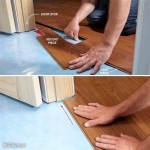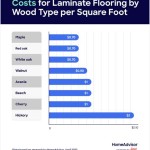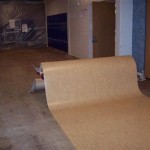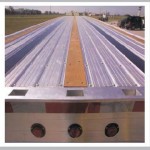Porcelain Plank Flooring: A Comprehensive Guide
Porcelain plank flooring has emerged as a popular choice for residential and commercial spaces, offering a compelling blend of aesthetic appeal and practical benefits. This material replicates the look of natural wood, stone, or other materials while providing the durability and water resistance inherent to porcelain. Understanding the characteristics, advantages, installation, and maintenance of porcelain plank flooring is crucial for making informed decisions about its suitability for specific applications.
Porcelain is a type of ceramic tile known for its density and low porosity. It is manufactured through a process of high-temperature firing, typically exceeding 2,300 degrees Fahrenheit. This process results in a hard, durable material with exceptional resistance to water absorption, stains, and scratches. The raw materials used in porcelain production commonly include clay, silica, feldspar, and other minerals. These materials are carefully blended, molded, and then fired to achieve the desired properties.
The "plank" designation refers to the shape and format of the tile. Porcelain planks are designed to mimic the appearance of wood planks, typically featuring elongated rectangular shapes and wood-grain patterns. However, designs can also emulate stone, concrete, or other materials, offering a wide range of aesthetic options. The elongated shape of the planks contributes to a realistic and visually appealing flooring surface that can enhance the overall design of a space.
Key Point 1: Durability and Longevity
One of the primary advantages of porcelain plank flooring is its exceptional durability. Its high density and low porosity make it highly resistant to wear and tear, making it suitable for high-traffic areas such as hallways, kitchens, and commercial spaces. Unlike natural wood, porcelain is not susceptible to moisture damage, warping, or splintering. This makes it an ideal choice for bathrooms, laundry rooms, and basements where humidity levels are typically higher.
The resistance to scratching is another notable benefit. Porcelain's hard surface can withstand the daily wear and tear associated with pets, furniture movement, and foot traffic. This makes it a particularly appealing option for households with children or pets. Its resistance to staining is equally important. Porcelain is inherently resistant to most common household stains, including spills from food, beverages, and cleaning products. This feature simplifies cleaning and maintenance, ensuring a long-lasting and aesthetically pleasing surface.
Furthermore, porcelain is resistant to fading from sunlight exposure. Unlike some natural materials, porcelain plank flooring maintains its color and appearance over time, even in areas with direct sunlight. This durability extends the lifespan of the flooring, reducing the need for frequent replacements and contributing to long-term cost savings.
Key Point 2: Aesthetic Versatility
Porcelain plank flooring offers considerable aesthetic versatility, allowing homeowners and designers to achieve a wide range of design styles. The ability to replicate the look of natural wood is a significant advantage, allowing for the creation of warm and inviting spaces without the maintenance concerns associated with real wood. Porcelain planks are available in a wide variety of wood-grain patterns, colors, and textures, allowing for customization to suit different preferences and interior designs.
Beyond wood-look options, porcelain planks can also mimic the appearance of stone, concrete, and other materials. This versatility makes it possible to achieve modern, rustic, or traditional design styles. The availability of different sizes and shapes further enhances design flexibility. Longer planks can create a sense of spaciousness, while narrower planks can add visual interest and texture. The ability to mix and match different sizes and patterns can create unique and personalized flooring designs.
The color consistency of porcelain is another advantage. Unlike natural materials, which can vary in color and shade, porcelain planks are manufactured with consistent color throughout the tile. This ensures a uniform and predictable appearance, which is particularly important for large installations. The color consistency also simplifies replacement if a tile is damaged, as the replacement will match the existing flooring.
The surface texture of porcelain planks can also be varied to enhance the realism and aesthetics of the flooring. Textured surfaces can mimic the natural grain of wood or the rough texture of stone. This adds depth and dimension to the flooring, creating a more authentic and visually appealing surface. Some porcelain planks also feature beveled edges, which further enhance the realism and create a more defined plank appearance.
Key Point 3: Installation and Maintenance
The installation of porcelain plank flooring requires careful preparation and attention to detail. Proper subfloor preparation is essential to ensure a level and stable surface. The subfloor should be clean, dry, and free of any debris or imperfections. Any unevenness should be addressed before installing the flooring. A cement backer board is often recommended to provide a stable and moisture-resistant base for the porcelain planks.
The installation process typically involves applying a thin-set mortar to the subfloor and then carefully setting the porcelain planks in place. Spacers are used to maintain consistent grout lines between the planks. Proper grout selection is important to complement the color and style of the flooring. The grout should be applied carefully and evenly, and any excess grout should be removed promptly. Sealing the grout is recommended to protect it from stains and moisture.
Maintenance of porcelain plank flooring is relatively straightforward. Regular sweeping or vacuuming is sufficient to remove dirt and debris. Damp mopping with a mild detergent is recommended for cleaning. Harsh chemicals and abrasive cleaners should be avoided, as they can damage the surface of the porcelain or the grout. Periodic cleaning with a specialized tile cleaner can help remove stubborn stains and maintain the appearance of the flooring.
Unlike natural wood, porcelain does not require sealing or refinishing. This significantly reduces the maintenance requirements and long-term costs associated with the flooring. The stain resistance of porcelain also simplifies cleaning, as most spills can be easily wiped up with a damp cloth. The low porosity of porcelain also prevents the growth of mold and mildew, making it a hygienic flooring option.
While generally durable, porcelain can be susceptible to chipping if subjected to severe impact. It is advisable to protect the flooring from heavy objects and sharp edges. Small chips can often be repaired with a color-matched repair kit. In cases of significant damage, the affected plank can be replaced. Proper installation and maintenance can help extend the lifespan of porcelain plank flooring and maintain its aesthetic appeal.
In summary, porcelain plank flooring offers a compelling combination of durability, aesthetic versatility, and ease of maintenance. Its resistance to water, stains, and scratches makes it a practical choice for a wide range of applications. The ability to replicate the look of natural wood and other materials allows for the creation of visually appealing and stylish spaces. While proper installation is essential, the long-term benefits and low maintenance requirements make porcelain plank flooring a worthwhile investment.

Porcelain Vs Ceramic Tile Learn The Difference Flooring Inc

Msi Antoni Platinum Porcelain Floor Tile

Wood Look Tile Ceramic Porcelain The

Classic Oak Plank Wood Effect Porcelain Floor Tile

Why Wood Look Tile Conestoga

Floors Wood Effect Porcelain Vs Engineered Oak Redbrook Kitchens

Porcelain Wood Look Tile Vs Luxury Vinyl Plank An Honest Comparison

Porcelain Tile Planks Vintage Reclaimed Wood Look

Msi Aspenwood Ash Porcelain Tile

Durable Porcelain Tile That Looks Just Like Natural Birch
Related Posts








